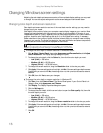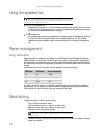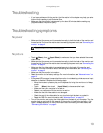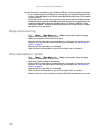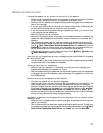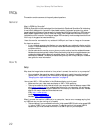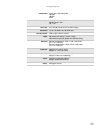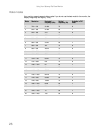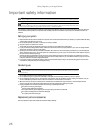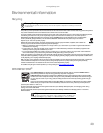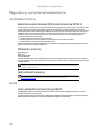
www.gateway.com
23
When I run my games, I do not see support for widescreen displays. What can I do?
• Newer games are adding support for widescreen displays as the widescreen format becomes
more popular. Check the game’s Web site for updates. You can also consult the following
Web site for specific settings and options to configure older games to support widescreen:
http://www.widescreengamingforum.com
.
Some adjustments may require you to make changes to the Windows System Registry. We
recommend making a complete system backup before changing the System Registry.
Technical
Why do I see “noise” or “trash” on the screen?
• When your display’s digital capabilities exceed a digital broadcast signal, the signal is
increased (up-converted) to match the display capabilities. Up-converting can cause “noise”
or “trash.” The signal on DVI-D is HDCP encoded. Stop and restart the source to allow
renegotiation.
What is HDCP and how do I troubleshoot it?
• High-bandwidth Digital Content Protection (HDCP) is a specification developed by the Intel®
Corporation to protect digital entertainment content that uses a digital visual interface (DVI).
HDCP encrypts the transmission of digital content (signal) between the video source
(computer, DVD player, or set-top box) and the digital display (monitor, digital television/DTV,
or projector). HDCP is not designed to prevent copying or recording of digital content, but
only to protect the integrity of the content as transmitted.
How does HDCP work?
• Implementation of HDCP requires a license obtainable from the Digital Content Protection,
LLC, which then issues a set of unique secret device keys to all authorized devices. During
authentication, the receiving device only accepts content after it acknowledges the keys. To
further prevent stealing of the data or line tapping, the transmitter and receiver generate
a shared secret value that is constantly checked throughout the transmission. After
authentication is established, the transmitter encrypts the data and sends it to the receiver
for decryption.
What happens if I lose signal to the display while watching a movie on a HDCP-equipped
component?
• The component must be restarted to establish renegotiation.
For example, while watching a movie on a HDCP-enabled DVD player, you change the
receiving device (DTV, monitor, or projector) input to watch broadcast TV, then change the
input back to watch the DVD movie. However, you are unable to watch the movie. This is
because when the input was changed, the receiver lost the HDCP signal. Restart the
HDCP-enabled DVD player to allow renegotiation.
What is the cause if a movie starts and then slowly fades to static?
• The receiving device is not HDCP compatible or it is not negotiating correctly. Restart the
video source and re-plug all video cables from the source to the TV.
How do I know if a component is HDCP compliant?
• If the video source device does not have a DVI or HDMI connection, it is not HDCP compliant.
Video/Display
When I display video from composite, or component, why does the video look overly
compressed?
• See your video device user manual to adjust the video or TV format output to 16:9. Setting
this option to 4:3 results in compressed video. This is done differently on all brands of video
devices, so it is important that you read your video device user guide or the help tools within
your video device’s software.




